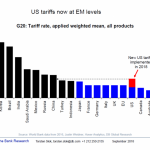The new rate regime has presented investors with a fixed income backdrop that hasn’t been witnessed in more than a decade and a half. Against this backdrop, bond portfolio decision-making has been presented with a new, or shall we say “old,” opportunity for positioning. PexelsWith income back in fixed income and uncertainty surrounding the macro outlook, investors can now turn to a time-tested strategy to help navigate the potentially choppy waters in the bond market going forward: laddered Treasury solutions.Certainly, a key benefit from the rise in U.S. interest rates from their COVID-19-related historical lows is that investors are now clearly presented with a better risk-return profile in the fixed income markets. As a result, more income has become available per unit of interest rate risk, with potential returns exceeding inflation. This bond market landscape stands in stark contrast to the zero interest rate policy (ZIRP) that was adopted and maintained by many central banks (including the Fed) for much of the 2010–2022 period. Yield/Duration for 2-Yr Treasury Note, 2000–2024
PexelsWith income back in fixed income and uncertainty surrounding the macro outlook, investors can now turn to a time-tested strategy to help navigate the potentially choppy waters in the bond market going forward: laddered Treasury solutions.Certainly, a key benefit from the rise in U.S. interest rates from their COVID-19-related historical lows is that investors are now clearly presented with a better risk-return profile in the fixed income markets. As a result, more income has become available per unit of interest rate risk, with potential returns exceeding inflation. This bond market landscape stands in stark contrast to the zero interest rate policy (ZIRP) that was adopted and maintained by many central banks (including the Fed) for much of the 2010–2022 period. Yield/Duration for 2-Yr Treasury Note, 2000–2024 Yield/Duration for 10-Yr Treasury Note, 2000–2024
Yield/Duration for 10-Yr Treasury Note, 2000–2024 This point can be underscored by the relationship between yield and duration from a historical perspective, as illustrated in the above graphs. In other words, investors are now able to achieve a visibly higher yield as it relates to the underlying duration of a Treasury security, whether it’s a 2- or a 10-year maturity. This development has brought a “return to normalcy” for the U.S. Treasury (UST) market that didn’t exist following the great financial crisis and through COVID-19. So, How Can Investors Take Advantage of This New (Old) Rate Regime?WisdomTree has created laddered Treasury strategies to take advantage of the opportunities that may now exist in the money and bond markets. We believe this time-tested approach offers diversified risk exposures around key parts of the yield curve and involves equal-weighted market exposures laddered across the maturity range.
This point can be underscored by the relationship between yield and duration from a historical perspective, as illustrated in the above graphs. In other words, investors are now able to achieve a visibly higher yield as it relates to the underlying duration of a Treasury security, whether it’s a 2- or a 10-year maturity. This development has brought a “return to normalcy” for the U.S. Treasury (UST) market that didn’t exist following the great financial crisis and through COVID-19. So, How Can Investors Take Advantage of This New (Old) Rate Regime?WisdomTree has created laddered Treasury strategies to take advantage of the opportunities that may now exist in the money and bond markets. We believe this time-tested approach offers diversified risk exposures around key parts of the yield curve and involves equal-weighted market exposures laddered across the maturity range.
- Investors who are looking to manage interest rate risk while also positioning their fixed income portfolio for shifts in Federal Reserve policy may consider the WisdomTree 1-3 Year Laddered Treasury Fund. WisdomTree 1-3 Year Laddered Treasury Fund seeks to track the price and yield performance, before fees and expenses, of the Bloomberg U.S. Treasury 1-3 Year Laddered Index.
- Investors who are looking to moderately add duration and position their bond portfolio for changes in growth and inflation expectations may consider the WisdomTree 7-10 Year Laddered Treasury Fund. WisdomTree 7-10 Year Laddered Treasury Fund seeks to track the price and yield performance, before fees and expenses, of the Bloomberg U.S. Treasury 7-10 Year Laddered Index.
Both strategies focus on the most recently issued securities that mature for a designated month or quarter to preserve a high level of liquidity within the strategy. Both strategies focus on a subset of available Treasury securities within the maturity bands, selecting the most recently issued securities that mature for a designated month or quarter. This focus seeks to further enhance the high degree of liquidity already present in investment in Treasury securities.There will be a monthly rebalancing for each Fund, where the 1–3-year Index rotates securities monthly while the 7–10-year Index reconstitutes quarterly, in line with the Treasury issuance of the new 10-Year note every February, May, August and November. Fed Funds Target Rate and Treasury Yields What Role Can Laddered Exposures to Short and Intermediate Treasuries Play in Investor Portfolios?Laddered Treasury strategies provide critical building blocks that we believe are straightforward, intuitive and disciplined while serving a variety of functions within investor portfolios. At their core, this approach may offer a source of high-quality income, with each strategy providing the ability to position around key points of the curve. As highlighted by the above graph, the shorter-dated UST sector of the yield curve is highly sensitive to expectations about Federal Reserve policy, while the intermediate part is more sensitive to changes in long-term growth and inflation expectations. ConclusionWith the addition of these new Laddered Treasury Funds (WisdomTree 1-3 Year Laddered Treasury Fund and WisdomTree 7-10 Year Laddered Treasury Fund) to our Floating Rate Treasury Fund (USFR), WisdomTree now offers investors a suite of Treasury products that can act as a powerful toolkit to effectively manage a variety of interest rate scenarios. More By This Author:Gold: Unique In Every WayMagnificent Seven Earnings (Mostly) ImpressFocus On The Fed Series: Taking Stock Of Fixed Income
What Role Can Laddered Exposures to Short and Intermediate Treasuries Play in Investor Portfolios?Laddered Treasury strategies provide critical building blocks that we believe are straightforward, intuitive and disciplined while serving a variety of functions within investor portfolios. At their core, this approach may offer a source of high-quality income, with each strategy providing the ability to position around key points of the curve. As highlighted by the above graph, the shorter-dated UST sector of the yield curve is highly sensitive to expectations about Federal Reserve policy, while the intermediate part is more sensitive to changes in long-term growth and inflation expectations. ConclusionWith the addition of these new Laddered Treasury Funds (WisdomTree 1-3 Year Laddered Treasury Fund and WisdomTree 7-10 Year Laddered Treasury Fund) to our Floating Rate Treasury Fund (USFR), WisdomTree now offers investors a suite of Treasury products that can act as a powerful toolkit to effectively manage a variety of interest rate scenarios. More By This Author:Gold: Unique In Every WayMagnificent Seven Earnings (Mostly) ImpressFocus On The Fed Series: Taking Stock Of Fixed Income













Leave A Comment